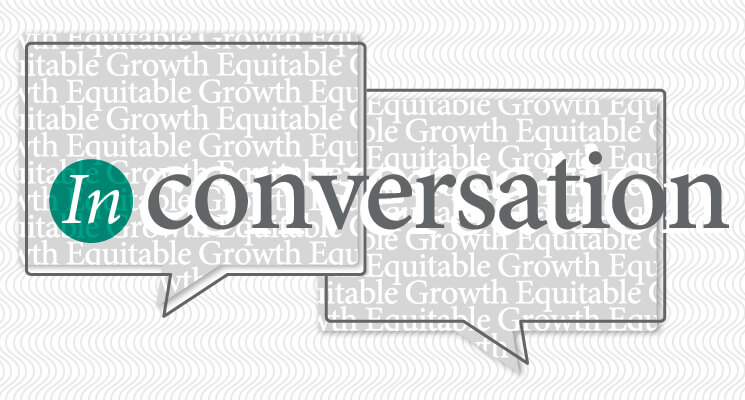Understanding how U.S. workers can benefit from workplace automation and artificial intelligence

The daily economic news cycle is awash with stories these days about the threat of automation and artificial intelligence to the future of work for hundreds of millions of U.S. workers. Amid near-hysteria over ostensibly widening “skills gaps” and deepening labor shortages in key U.S. production and services industries—stories that are especially scary as the coronavirus pandemic enters its third year—workers across the country are hearing that these technologies are inexorably destroying their sources of livelihoods now and well into the future.
These stories could not be more pessimistic about the future of work in our nation. And they could not be more wrong. The reason? Technology is not like gravity. Workplace automation and artificial intelligence technologies do what the humans who design and deploy them are rewarded to have them do. Those rewards can be changed.
To be sure, workers’ fears of technological change aren’t without basis. Yet the biggest technology opportunities have always augmented the work of humans, rather than replaced it altogether. New technological breakthroughs could amplify this trend, combining machine efficiency with human empathy to make people’s interactions more efficient and effective. Artificial intelligence and machine learning will enable teams of people to learn much faster than before.
Before I detail the kinds of steps that need to be taken and detail the kinds of evidence-based research that could be conducted to make this happen, it makes sense to first briefly walk through why so many falsely believe that technology and automation are taking over our jobs.
2022 Request for Proposals
November 10, 2021
A key contributor to common fears regarding technology is that the jobs of working people without bachelor’s degrees—which some pejoratively and wrongly view as “unskilled” occupations—are considered most likely to be eclipsed by computers, automation, and artificial intelligence and are first in line to be automated. Some say that these kinds of workers need to be “upskilled” to find work in the current and post-pandemic U.S. economy, or they will be “replaced by the robots.”
Another common denominator in this fear about the future of work is the experience many of us face when applying for jobs. Despite a record number of open jobs, getting hired hasn’t gotten any easier for the millions searching for work. It also is readily apparent that outdated hiring practices screen out qualified applicants such that “the endless quest to make hiring efficient has rendered it inefficient,” explain Rani Molla and Emily Stewart at Vox.
First and foremost, the idea that workers in our economy are unskilled is false. In fact, employers play a lead role in building these kinds of destructive automation processes—ones that, by and large, do not benefit them or their employees and prospective new hires. And employers can play a lead role in dismantling these practices by being held accountable for how they use these technologies for their own benefit and for the greater prosperity of U.S. workers and their families and the broader U.S. economy.
With the rise of automated hiring processes, many companies use “bachelor’s degree” as a keyword search in their applicant tracking system, which omits candidates before any human gets to consider them. This one choice automatically screens out approximately 60 percent of all U.S. workers. But it’s not the applicant tracking system that is choosing how or who to screen; it is the humans behind it. The equitable answer to this hiring inefficiency is to look for talented individuals who are “Skilled Through Alternative Routes,” or STARs, by removing out-of-date barriers and letting workers shine because of their skills.
National awareness and validation for the STARs talent category is growing—just last week, The New York Times profiled new insights on STARs from our latest report, “Rise with the STARs,” which quantifies the damage done by two decades of rising career barriers to more than 70 million U.S. workers skilled through alternative routes. These STARs don’t have bachelor’s degrees, but they have gained skills through community colleges, military service, training programs, skills bootcamps, and on-the-job learning.
Two papers in the National Bureau of Economic Research build on the body of work about STARs, including:
- “Searching for STARs,” which segments and presents the more than 30 million STARs with trajectories to higher wages based on their skills
- “Skills, Degrees and Labor Market Inequality,” which presents rigorous quantitative analysis to show workers with bachelor’s degrees have dramatically better access to higher-wage occupations than STARs, exacerbating inequality between these groups
In this way, individuals’ skills will be augmented by technology, enabling them to succeed in more valuable, reconfigured jobs that meet real needs. As a result, workers will need to be trained to perform what Federal Reserve economists have called “opportunity occupations,” or those that require modest upskilling and pay more than their previous jobs. Businesses that create the conditions for these kinds of augmented technologies to flourish will deliver more overall productivity. They will be rewarded for the rapid reskilling of their workforces, enabling more inclusive innovation, creativity at every level, greater openness to change, better earnings, and more fulfilling experiences for workers and their managers alike.
Indeed, employers have already automated many routine tasks in the workplace. Today, most of what workers get paid for is effective interactions, such as communicating, problem-solving in teams, learning what users value, and finding the “sweet spots” that make companies and their customers better off. These kinds of tasks will be enhanced, not replaced, by technology.
Policymakers also need to come to grips with the institutional blockers to progress. Policies need to be put in place so that the use of technology improves the experiences, earnings, opportunities, and outcomes of working Americans and their families. In short, policymakers and economists alike need to stop blaming the tools and start fixing the rules. We need to make technology an empowering tool in the hands of workers—not because of luck, but through deliberate choices, including long-term investments, by our government, industry, and citizenry.
There is a key role for scholars to help us understand how best to handle the transformation of workplaces due to automation and artificial intelligence. The Washington Center for Equitable Growth, through its grant giving and its network of scholars, is a place where researchers come together and analyze the causes and consequences of the multiple dimensions of inequality, including in U.S. workplaces and across the U.S. workforce. The impact of technology on our lives—and on the future of meaningful work—is the result of research, investment, regulatory action, and business-model choices that are made by people. Together, we can make the future of work one of hope and prosperity, not disillusionment and despair.






